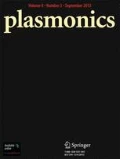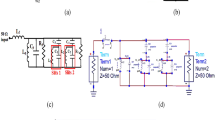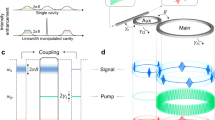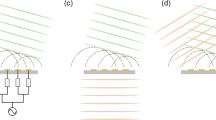Abstract
A unique device is proposed for ultra-high density up- and downlink transmission. The device comprises of the chalcogenide Mach–Zehnder interferometer (MZI) and panda ring resonator with silver bars at the center microring at the upper and lower parts of the MZI. The device is operative based on the space–time function where the input space (soliton) via the input port multiplexes with time at the add port of the device with a wavelength bandwidth of 1.50–3.50 µm and the frequency bandwidth of 85–250 THz. The WGM is observed at the upper (uplink) and lower (downlink) center microring with suitable parameters. The silver bars at the center microring form the dipole oscillation, where the uplink and downlink plasmonic antennas have the directivity 18.68 and 13.27, and gain is 9.34 and 6.64, respectively. The light fidelity (LiFi uplink and downlink) employs the wavelength spectrum while the wireless fidelity (WiFi uplink and downlink) employs the frequency spectrum. The LiFi uplink and downlink have an optimum wavelength of 2.30 µm and 2.27 µm, respectively, while the WiFi uplink and downlink have an optimum frequency of 130 THz and 132 THz. For the transmission signal, the bit rate of 28 Pbits−1 is achieved. The bit error rate (BER) value of 0.36 is obtained which indicates the system performance. Low BER value indicates high system performance. The device can be employed for the coverage of the light-wave and microwave wavelength link for 6G communication, where AI (artificial intelligence), 3D communication, code encryption, and secured transmission can be applied.








Similar content being viewed by others
References
Dang S, Amin O, Shihada B, Alouini MS (2020) What should 6G be. Nature Electronics 3:20–29
Zhou Y et al (2020) "Service aware 6G: An intelligent and open network based on convergence of communication, computing and caching". Digital Communications and Networks. 1–9
Ma X et al (2020) Intelligent reflecting surface enhanced indoor terahertz communication systems. Nano Communication Networks 24(100284):1–33
Jiang T et al (2020) “6G perspectives: techniques and challenges”. Digital Communications and Networks
Alsharif MH, Kelechi AH, Albreem MA, Chaudhry SA, Zia MS, Kim S (2020) Sixth generation (6G) wireless networks: Vision, research activities, challenges and potential solutions. Symmetry 12(4):1–21
Sergiou C, Lestas M, Antoniou P, Liaskos C, Pitsillides A (2020) Complex systems: A communication network perspective toward 6G. IEEE Access 8:89007–89030
Viswanathan H, Mogensen PE (2020) Communication in the 6G era. IEEE Access 8:57063–57074
Huang T, Yang W, WU J, MA J, Zhang X, Zhang D (2019) A survey on green 6G network: Architecture and technologies. IEEE Access 7:175758–175768
Rappaport TS et al (2019) Wireless communications and applications above 100 GHz: Opportunities and challenges for 6G and beyond. IEEE Access 7:78729–78759
Chen Y, Liu W, Niu Z, Feng Z, Hu Q, Jiang T (2020) “Pervasive intelligent endogenous 6G wireless systems: Prospects, theories and key technologies”. Digital Communications and Networks. 1–14
Lu Y, Zheng X (2020) 6G: A survey on technologies, scenarios, challenges, and the related Issues. Journal of Industrial Information Integration 19(100158):1–51
Wang M, Zhu T, Zhang T, Zhang J, Yu S, Zhou W (2020) “Security and privacy in 6G networks: New areas and new challenges”. Digital Communications and Networks. 1–16
Manogaran G et al (2020) “Blockchain based integrated security measure for reliable service delegation in 6G communication environment”. Computer Communications. 1–20
Khan WU, Jameel F, Jamshed MA, Pervaiz H, Khan S, Liu J (2020) Efficient power allocation for NOMA-enabled IoT networks in 6G era. Physical Communication 39(101043):1–10
Adeogun R, Berardinelli G, Mogensen PE, Rodriguez I, Razzaghpour M (2020) Towards 6G in X-subnetworks with sub-millisecond communication cycles and extreme reliability. IEEE Access 8:110172–110188
Dash S, Patnaik A “Performance of graphene plasmonic antenna in comparison with their counterparts for low-terahertz applications”. Plasmonics.13, 2353–2360
Kalraa S et al (2020) Investigation of As2S3-borosilicate chalcogenide glass-based dispersion-engineerd photonic crystal fibre for broadband supercontinuum generation in the mid-IR region. J Mod Opt 67(10):920–926
Punthawanunt S, Aziz MS, Phatharacorn P, Chiangga S, Ali J, Yupapin P (2018) LiFi cross-connection node model using whispering gallery mode of light in a microringresonator. Microsyst Technol 24(12):4833–4838
Chaiwong K, Bahadorun M, Amiri IS, Youplao P, Pornsuwancharoen N, Yupapin P (2018) Electric-optic conversion circuit incorporating a fiber optic loop for light fidelity up-down link use. Microwave and Optical Technology Letters 61(2):526–531
Tunsiri S, Thammawongsa N, Threepak T, Mitatha S, Yupapin P (2019) Microring switching control using plasmonic ring resonator circuits for super-channel use. Plasmonics 14:1669–1677
Schuller JA, Barnard ES, Cai W, Jun YC, White JS, Brongersma ML (2010) Plasmonics for extreme light concentration and manipulation. Nature Mater 9:193–204
Agrawal GP (2011) “Nonlinear fiber optics: its history and recent progress”, [invited]. Journal of Optical Society America B 28(12):A1–A10
Sarapat N et al (2019) LiFi up-downlink conversion node model generated by inline successive optical pumping. Microsyst Technol 25:945–950
Arumona AE, Garhal A, Punthawanunt S, Ray K, Youplao P, Yupapin P ( 2020) “Micro-metamaterial antenna characteristics using microring embedded silver bars”. Microsystem Technologies. 1–6
OptiFDTD Technical Background and Tutorials (Finite Difference Time Domain Photonics Simulation Software. https://www.optiwave.com, Accessed on 30th June, 2020
Garhwal A, Ray K, Arumona AE, Bharti GK, Amiri IS, Yupapin P (2020) Spin-wave generation using MZI embedded plasmonic antennas for quantum communications. Journal of Optical and Quantum Electronics 52(241):1–12
Wiesner K (2009) “Quantum cellular automata”, In: Meyers R. (eds) Encyclopedia of complexity and systems science. Springer, New York
Arumona AE, Amiri IS, Punthawanunt S, Yupapin P (2020) High-density quantum bits generation using microring plasmonic antenna. Journal of Optical and Quantum Electronics 52(208):1–12
Arumona AE, Punthawanunt S, Ray K, Phunklang S, Yupapin P (2020) “Electron cloud spin generated by microring space-time control circuit for 3D quantum printing”. Microwave and Optical Technology Letters. 1–7
Bunruangses M, Youplao P, Amiri IS, Pornsuwancharoen N, Yupapin P (2019) Brain sensor and communication model using plasmonic micrring antenna network. Opt Quant Electron 51(349):1–10
Bunruangses M, Sunat K, Mitatha S, Yupapin P (2010) Vehicular ad hoc network for a surveillance system using multifrequency band enhancement. Opt Eng 49(9):1–7
Babar S, Weaver JH (2015) Optical constants of Cu Ag and Au revisited. Appl Opt 54(3):477–481
Bahadoran M, Jalil MA, Ali J, Amiri IS, Yupapin P (2020) Realizing unique bifurcation model in a cascaded microring feedback circuit. Journal of Optical and Quantum Electronics 52(216):1–14
Pornsuwancharoen N et al (2017) Micro-current source generated by a WGM of light within a stacked silicon-graphene-Au waveguide. IEEE Photonics Technol Lett 29(21):1768–1771
Blaber MG, Arnold MD, Ford MJ (2009) Search for the ideal plasmonic nanoshell the effects of surface scattering and alternatives to gold and silver. J Phys Chem C 113:3041–3045
Chowdhury MZ, Hossan MT, Islam A, Jang YM (2018) A comparative survey of optical wireless technologies architectures and applications. IEEE Access 6:9819–9840
Pengnoo M et al (2020) Digital twin for metasurface reflector in 6G terahertz communications. IEEE Access 8:114580–114596
Acknowledgements
One of the authors (Mr. Arumona) would like to thank the Ton Duc Thang University, Vietnam for their financial support. This research is funded by the Foundation of Science and Technology Development of Ton Duc Thang University (FOSTECT), website: http://fostect.tdtu.edu.vn, under the research grant number FOSTECT.2017.BR.07.
Funding
This research is funded by the Foundation of Science and Technology Development of Ton Duc Thang University (FOSTECT), website: https://fostect.tdtu.edu.vn, under the research grant number FOSTECT.2017.BR.07.
Author information
Authors and Affiliations
Contributions
Arumona Edward Arumona: simulation, analyzed, writing and revision; Anita Garhwal: graphic improvement and discussion; Montree Bunruangses: Matlab results improvement and discussion; Kanad Ray: discussion and premium quality improvement; Phichai Youplao: comparing Optiwave and Matlab results, and discussion; Suphanchai Punthawanunt: discussion and English polishing; Preecha Yupapin: modeled, analyzed, discussion, final editing and submission. All authors have read through the manuscript.
Corresponding author
Ethics declarations
Consent to Participate
All authors are pleased to publish in this article.
Consent to Publish
All authors are welcome to publish this article.
Competing Interests
The authors declare that they have no conflict of interest.
Additional information
Publisher’s Note
Springer Nature remains neutral with regard to jurisdictional claims in published maps and institutional affiliations.
Rights and permissions
About this article
Cite this article
Arumona, A.E., Garhwal, A., Bunruangses, M. et al. Plasmonic Antenna Embedded Chalcogenide MZI Circuit for Ultra-high Density Up- and Downlink Transmission. Plasmonics 16, 947–955 (2021). https://doi.org/10.1007/s11468-020-01323-3
Received:
Accepted:
Published:
Issue Date:
DOI: https://doi.org/10.1007/s11468-020-01323-3




